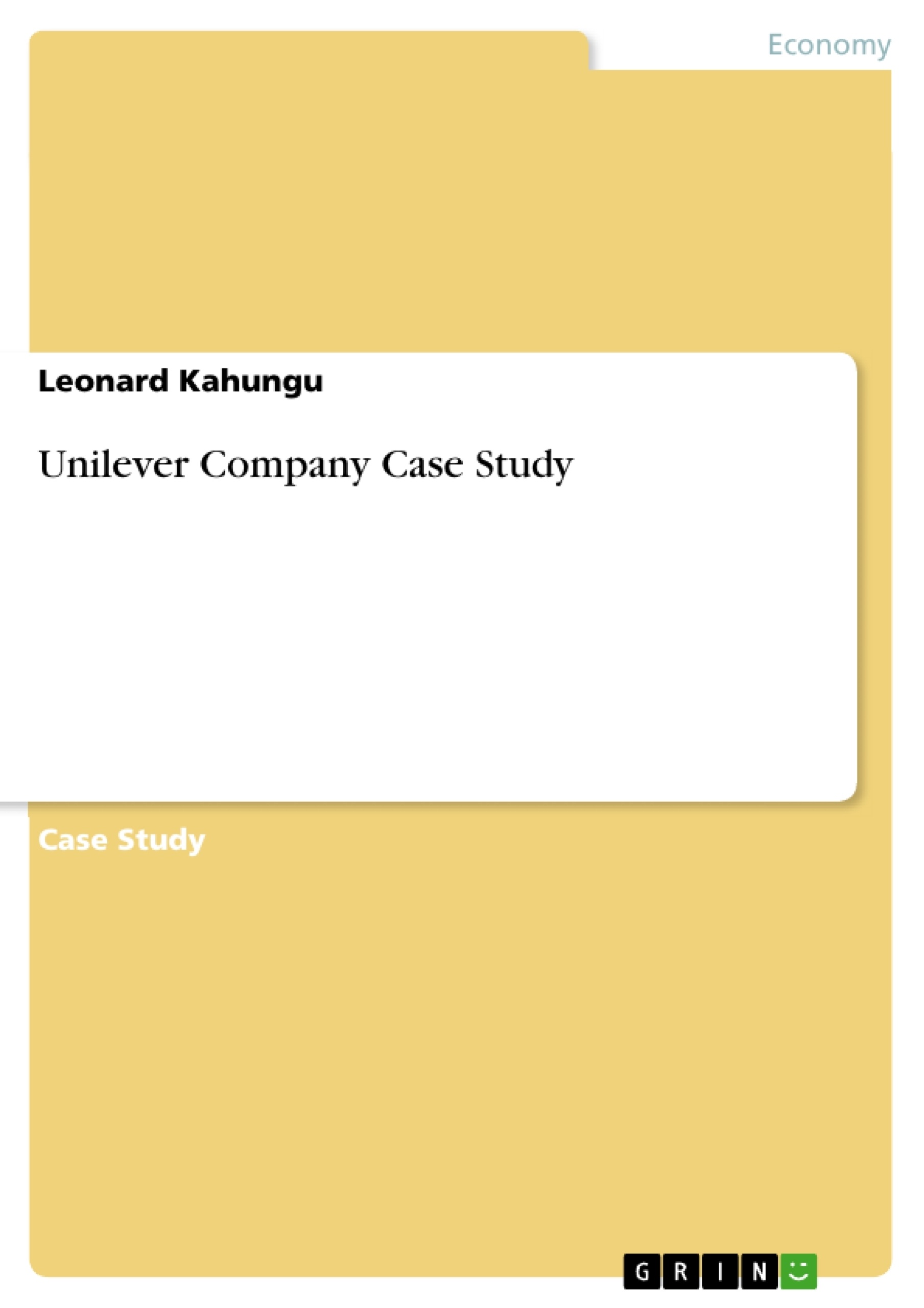Excerpt
Contents
Introduction
Balanced Scorecard Analysis
Financial Perspective
Customer Perspective
Internal Perspective
Innovation and Learning Perspective
SWOT Analysis
Strength and Weaknesses
Opportunities and Threats
PESTEL Analysis
Political Factors
Economic Factors
Social Factors
Technological Factors
Legal Factors
Environmental Factors
Industrial Life Cycle
Porter’s Five Analysis
Bargaining Power of Suppliers
Bargaining Power of Buyers
Threats of New Entrants
Threats of Substitute Products
Competitive Rivalry in the Market
Benchmarking
McKinsey 7S Analysis
Strategy
Styles
Shared Values
Systems
Structure
Staff
Skills
Impending Challenges Facing Unilever
Major Challenge Affecting Unilever
Porter’s Generic Strategies
Conclusion
Unilever Company Case Study
Introduction
Unilever is London-based multinational company that specialises on fast-moving consumer products in more than 190 countries across the globe. However, Unilever is increasingly facing stiff competition from local, regional, and international companies in virtually all levels from rival firms (Unilever, 2016). The competition is reflected across its over 400 brands in four predominant categories, namely personal care, refreshments, home care, and foods. This calls for a strategic analysis of the company in attempts to identify sustainable recommendations in attempts to enhance the performance and competitiveness of Unilever around the world.
Balanced Scorecard Analysis
Financial Perspective
The financial perspective looks very promising, as the company has the required resouorces to enhance its investments. Nonetheless, the turnover growth is also optimistic except that the profitability is gradually dimishing.
Abbildung in dieser Leseprobe nicht enthalten
Figure 1 Source (Unilever 2016)
Abbildung in dieser Leseprobe nicht enthalten
Figure 2 (Unilever 2016)
Customer Perspective
This entails consumer retention profitability, market shares, retention, and acquisitions. Unilever has a unique and strong brand that has earned it reputation among the consumers and competitors alike. Unilever has also acquired a list of different companies across the globe in attempts to expand its customer base (Raj and Aithal, 2018).
Internal Perspective
This entails the measurements against internal chain for innovations, operations and post sales services. Unilever has managed to establish a niche of healthy living; in which it identifies the increasing needs of a healthy living of the contemporary consumers. Most people are increasingly focusing on healthy products, which are provided within the 400 brands affiliated to Unilever (Melton et al., 2017).
Innovation and Learning Perspective
This integrates employee retention, morale, skills along with the systems. Unilever has invested on the Workday tools, which allows the management of the organisation across the globe. This tool provides details concerning the human resources, financial arrangement, and other day-today operations of the company across the globe (Karagiannopoulos et al., 2015). This application allows the organisation to make informed decisions based on real time data.
SWOT Analysis
Abbildung in dieser Leseprobe nicht enthalten
Figure 3: Source (Stein et al., 2016)
Strength and Weaknesses
Unilever operates in over 190 countries around the world, which gives it a string brand name and a footprint in the global market. It also enjoys a wide range of markets as a result of its product diversification approaches in the company. This allows it to enjoy the economies of large scale production (Stein et al., 2016). However, Unilever products can easily be replaced by substitutes, particularly in the emerging markets in Asian and African regions. Unilever also operates in a highly competitive market, weakening its market shares in the Fast Moving Consumer Goods (FMCG).
Opportunities and Threats
Globalisation has in the resent past facilitated the proliferation of global media, which fosters the assimilation of the western culture across the world. This will increase the scope and magnitude of the FMCG markets, which translates to the expansion of Unilever distribution, demand, and potential growth. Unilever has an opportunity to tap into the newly emerging markets with a positive outlook on the economic performance of most countries (Siaw and Yu, 2004). In particular, the economic growth in China and India means that the company can tap into these markets. Health concerns have been on the rise due to chronic conditions and morbidity patterns that are linked to unhealthy lifestyles. Unilever has an opportunity to invest in this market niche that seeks to capitalise on the health conscious clients across the globe.
Consequently, economic crisis in the recent past has significantly affected the profitability of numerous companies in the FMCG market, including Unilever. The Company operates in an environment where goods substitution costs nothing (Dobbs, 2014). In the wake of escalating FMCG market competitiveness, Unilever faces a major threat from emerging and new breeds of companies that are highly efficient in the local and regional markets. Unilever has attracted sharp criticism due to some of its business models. This criticism threatens the brand reputation attributed to its products across the world.
PESTEL Analysis
Abbildung in dieser Leseprobe nicht enthalten
Figure 4: Source (Dobbs, M., 2014).
Political Factors
Unilever’s headquarters are based in London and Amsterdam. The government systems in the United Kingdom and Netherlands are known to have a long history of stability are among the initial members championing the European Union formulation. These factors are paramount for the flourishment of FMCG along with corporate governance. Nonetheless, Netherlands has in the past threatened to pull out of the EU, in which the then Prime Minister, 2012, as a means to enhance the Dutch economy (Günther, 2011). Recently, the UK pulled out of the EU in what has since been referred to as Brexit. Initially, the Eurozone provides a common market with reduced trade barriers. Thus, Brexit and similar sentiments are likely to compel Unilever to invest more on localisation strategy as trade barriers in the EU continues to increase. This will also affect the corporate governance structures as they are currently constituted due to increasing legal and political factors.
[...]
- Quote paper
- Leonard Kahungu (Author), 2018, Unilever Company Case Study, Munich, GRIN Verlag, https://www.grin.com/document/428631
Publish now - it's free






















Comments